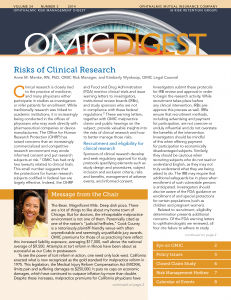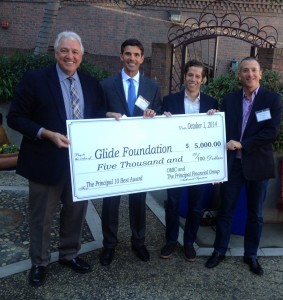Top 10 OMIC Stories of 2014
 2014 was a year of great accomplishments and milestones for our company. We’ve chosen our top 10 from OMIC’s Blog, in descending order, for the most significant stories affecting OMIC during 2014. (Click on each title to link to more information for the story)
2014 was a year of great accomplishments and milestones for our company. We’ve chosen our top 10 from OMIC’s Blog, in descending order, for the most significant stories affecting OMIC during 2014. (Click on each title to link to more information for the story)
10. OMIC introduces a new online cyber liability risk management resource portal at OMIC.com.
Recognizing emerging cyber exposures associated with electronic medical records and the potential threat posed to our insureds, cyber liability coverage was added under the supplementary benefit of OMIC’s professional liability policy in 2011. Read more about this coverage here. The new cyber risk management portal guides you through state-specific analysis of your risks and provides tools to reduce risk. It also explains how to respond to a breach and provides training tools for staff and sample policy documents to provide to your employees.
9. OMIC’s policyholder service and application process goes online.
Earlier this year, OMIC unveiled MyOMIC Policyholder Services, where policyholders may perform a variety of transactions online, including payments, coverage and policy review, certificates and proof of insurance and many other service related functions. We also introduced an electronic application system through which new insureds may apply for coverage at OMIC.com. An electronic renewal application system will be live in early 2015.
8. OMIC nears 50 partnerships with ophthalmic societies.
We added 4 new societies to our list of partnerships; New Jersey Academy of Ophthalmology (NJAO), Massachusetts Society of Eye Physicians and Surgeons (MSEPS), Rhode Island Society of Eye Physicians & Surgeons (RISEPS), and the National Medical Association. OMIC maintains educational alliances with most ophthalmic societies in the United States. We share patient safety and risk management resources and also support local lobbying and tort reform efforts. Policyholders who are members of societies with an OMIC partnership earn a 10% risk management discount when they complete an approved OMIC risk management event.
7. OMIC is chosen by The Principal and Inc. Magazine as one of the nation’s “10 Best Companies for Employee Financial Security in America”
For more than a quarter century, OMIC has produced consistently superior results for its policyholders. Now OMIC has been recognized as one of a small and select group of companies that excel at giving their employees a financial edge as well. The Principal® and Inc. Magazine chose OMIC as one of the 10 Best Companies for Employee Financial Security in America.
6. OMIC Covers Bilateral Intraocular Refractive Surgery
After careful consideration and analysis of available data regarding the performance of immediately sequential bilateral refractive lens exchange and phakic implant surgery, OMIC has approved coverage for these procedures subject to special conditions for patient selection, informed consent, and surgical protocols.
5. OMIC Increases Coverage Limit on Policy Benefits
We were pleased to announce that your standard policy benefit limits for all 14 included regulatory and cyber exposures increased from $50,000 to $100,000 per policy year effective January 1, 2015. Learn more about all of the benefits within your standard policy by visiting the Additional Benefits page.
4. OMIC Declares Another 25% Dividend to be Paid in 2015
Benjamin Franklin graces the front of the $100 bill and if you’re an OMIC-insured physician you’ll (again) be seeing a lot more of him next year. OMIC has declared dividends totaling $58 Million since our inception, placing us in a leading role among our peers for average annual dividend returns.
3. OMIC, the American Academy of Ophthalmology (AAO), and Pan-American Association of Ophthalmology (PAAO) publish a library of consent forms translated into Spanish.
With financial support from the Bruce E Spivey Fund for Risk Management Studies, OMIC works with the above societies to publish a full collection of Spanish language forms on OMIC’s web site. OMIC has made significant donations to the Spivey Fund for projects such as this, which will serve to improve both loss prevention and patient education and safety.
2. California’s Prop 46 is Defeated at the Polls.
OMIC contributed to defeat of this destructive proposition as a member of CAPP. The Californians Allied for Patient Protection (CAPP) initiative was critical to protect MICRA, tort reform that has been instrumental in keeping malpractice costs manageable and protecting patients access to health care. Because California initiatives are often a bellweather for tort actions in other parts of the country, the fight to maintain MICRA was a top priority for ophthalmic practice.
And the top OMIC story of 2014 is…
1. Tamara R. Fountain, MD, Assumes Leadership of OMIC
The appointment of Dr. Fountain as OMIC’s seventh Board Chair marked a new direction for the company and a commitment to the principals that made us the largest and most successful carrier in our field. Read Dr. Fountain’s latest Message from the Chair.
Season’s Greetings and Happy New Year in 2015!
 Instead of sending a traditional holiday card, OMIC made a donation to the following charities that directly benefit eye care and research.
Instead of sending a traditional holiday card, OMIC made a donation to the following charities that directly benefit eye care and research.
Visit these organizations to learn more about their great work.
Risks of Clinical Research
 Anne M. Menke, RN, PhD, OMIC Risk Manager, and Kimberly Wynkoop, OMIC Legal Counsel
Anne M. Menke, RN, PhD, OMIC Risk Manager, and Kimberly Wynkoop, OMIC Legal Counsel
Clinical research is closely tied to the practice of medicine, and many physicians either participate in studies as investigators or refer patients for enrollment. While traditionally research was linked to academic institutions, it is increasingly being conducted in the offices of physicians who may work directly with pharmaceutical companies or device manufacturers. The Office for Human Research Protection (OHRP) has raised concerns that an increasingly commercialized and competitive research environment may erode informed consent and put research subjects at risk.1 OMIC has had only two lawsuits related to clinical trials. This small number suggests that the protections for human research subjects codified in federal law are largely effective. Indeed, the OHRP and Food and Drug Administration (FDA) monitor clinical trials and issue warning letters to investigators, institutional review boards (IRBs), and study sponsors who are not in compliance with these federal regulations.2 These warning letters, together with OMIC malpractice claims and public hearings on the subject, provide valuable insights into the risks of clinical research and how to better manage those risks.
Recruitment and eligibility for clinical research
Sponsors of clinical research develop and seek regulatory approval for study protocols specifying elements such as study design and procedures, subject inclusion and exclusion criteria, risks and benefits, management of adverse events, and informed consent.
Investigators submit these protocols for IRB review and approval in order to begin the research activity. While recruitment takes place before any clinical intervention, IRBs pre-approve this process as well. IRBs ensure that recruitment methods, including advertising and payment for participation, are not coercive or unduly influential and do not overstate the benefits of the intervention. Investigators should be mindful of this when offering payment for participation to economically disadvantaged subjects. Similarly, they should be cautious when recruiting subjects who do not read or understand English, as they may not truly understand what they are being asked to do. The IRB may require that additional safeguards be in place when enrollment of such vulnerable persons is anticipated. Investigators should also be aware of the FDA guidance on enrollment of and special protections for certain populations (such as children and pregnant women).
Related to recruitment, eligibility determination presents additional concerns. Of the FDA warning letters to ophthalmologists we reviewed, all four cite failure to adhere to study enrollment criteria. When FDA staff conducted an investigation of one ophthalmologist, they found that 75% of the subjects did not meet inclusion criteria. In two of the letters related to one research center, the FDA found that scans taken to document the presence of the qualifying disease were performed incorrectly, indicating that the subjects may not have been eligible for the study. Another investigation showed that subjects did not meet visual acuity inclusion criteria. Investigators who receive warning letters face possible exclusion from research if concerns raised in the letter are not promptly and adequately addressed. They may also face lawsuits for negligence if the subjects of their research are harmed by investigational treatment for which they did not meet eligibility criteria, just as a physician would if a patient was injured during unnecessary surgery outside of research.
Benefits of adherence to study protocols
As the warning letters regularly state, adhering to study protocols protects subjects and ensures the integrity and quality of the data generated from the research. It can also protect investigators who are sued when subjects experience adverse events. For example, an OMIC-insured ophthalmologist recommended that his patient, who had age-related macular degeneration, enter a clinical trial being conducted at his office to test the effectiveness of a depot steroid injection. On the last injection of the study protocol, the cannula entered the globe, leading to a retinal break and tear. Unhappy with her final visual acuity of 20/80, the patient sued the pharmaceutical company as well as an OMIC-insured medical entity and two OMIC-insured ophthalmologists, one of whom was the study director. Experts reviewing the care determined that the insureds had properly enrolled the subject in the trial, obtained informed consent, complied with the study protocol, performed the procedure, and managed the adverse event. The experts noted that the study sponsor knew that scarring from prior injections made subsequent procedures more difficult. They concluded that while the injury was due to the study drug and procedure, the insureds met the standard of care. The defense attorneys contacted the sponsor, who had signed an agreement with the insured group to indemnify, defend, and hold them harmless for any adverse effect of the drug on a subject as long as they complied with the protocol and met the standard of care. The sponsor accepted the experts’ review and agreed to settle the case in exchange for a dismissal of the ophthalmologists and entity. Physicians engaged in clinical trials of drugs and devices can benefit from such agreements with study sponsors. Please see Policy Issues for more details.
Informed consent for research
Physicians are familiar with the information that must be provided to patients during the informed consent process, such as the condition, procedure, risks, benefits, and alternatives. Federal regulations impose additional elements for research-related informed consent, including a statement on the purpose, duration, and experimental procedures of the research. The regulations also stipulate that consent for research must be sought only under circumstances where the subject has a sufficient opportunity to consider whether to participate and that minimize the possibility of coercion or undue influence. To this effect, the form must state that participation is voluntary and that refusing or discontinuing participation will cause no loss or penalty.
The consent form must also address the extent to which the investigator intends to maintain the confidentiality of records identifying the subject and the possibility, if applicable, that the FDA, sponsor, IRB, or other involved parties may inspect such records. Absolute protection of confidentiality by the FDA should not be promised or implied since disclosure to third parties may be required. The form should also alert subjects that their records automatically become part of the research database.
Additionally, consent forms must address what will happen and whether there is compensation if injury occurs (see Hotline). However, federal regulations expressly prohibit exculpatory language and clarify that subjects may not be asked or implied to waive their legal rights or release the investigator, sponsor, institution, or its agents from liability for negligence. Recent draft guidance clarifies that a waiver may be permissible if it does not free another from liability. This was a change in position for the government; for example, it is now permissible for a subject to waive his or her rights to compensation for biospecimens provided to investigators.
While not required, investigators should consider the potential effects that a financial relationship might have on the research or their interactions with subjects. They should consider including information in the consent document about the source of funding and financial arrangements for the research. They may also want to modify the consent process when a potential or actual conflict exists.
A written form including these essential components generally must be submitted for IRB review and approval as part of the study protocol. While IRBs have the final authority for ensuring the adequacy of the information in the consent document, the language does not always pass governmental muster. A recent controversy about a multisite pediatric clinical trial called SUPPORT (Surfactant, Positive Pressure, and Oxygenation Randomized Trial), which tested the effects of varied oxygen levels on retinopathy of prematurity (ROP) and chronic lung disease, highlights the difficulty in ensuring the adequacy of the consent process. SUPPORT, conducted from 2004 to 2009, was sponsored by the National Institute of Health and approved by 23 IRBs. OHRP received and responded to a complaint one year after publication of the results. In the warning letter sent to the lead study site, OHRP claimed that the study consent form failed to describe the reasonably foreseeable risks of blindness, neurological damage, and death due to the random assignment of premature infants to higher or lower ranges of oxygen. While the study protocol discussed prior studies that raised concerns about the consequences of both high and low levels of oxygen on survival and brain, lung, and eye health, the “Risks” portion of the consent form did not include this information.
A number of physicians and ethicists responded to the warning letter in peer-reviewed journals, and organizations such as Public Citizen weighed in. The investigators argued that infants were at minimal risk since oxygen levels during the trial would be kept within the range provided in NICUs at the time. Conversely, OHRP found that randomly assigning and confining subjects to either the lower or upper portion of the range was not the same treatment most infants would have received had they not participated in the study. Therefore, the study intervention and attendant risk and potential benefits differed from those of the “standard of care.” SUPPORT critics, agreeing with OHRP, felt that the parents needed to be informed not only of known concerns about both high and low levels of oxygen, but that the pulse oximeter had been altered to hide the true oxygenation level from providers. OHRP acknowledged the need for better guidance on informed consent for trials comparing known treatments and convened a public hearing in 2013 to gather input that will inform future regulations.
Several principles emerged from the articles and the public hearings. Subjects need to know the difference between the care they would normally get and the care that will be provided during the study as well as the purpose and consequence of randomization. An informative example was cited in some letters and comments. In the US trials, the risk section of the consent form stated that “Because all of the treatments proposed in the study are standard of care, there is no predictable increase of risk to your baby.” The oxygen study also took place in New Zealand (NZ), where it was known as the BOOST trial. The NZ consent form explained that too low of an oxygen level could lead to an increase in the risk of death, poor growth, brain damage, or developmental problems, while too high of a level could lead to an increase in the risk of lung disease or ROP and blindness. US governmental representatives commented that the NZ consent form adequately addressed the foreseeable risks and met federal requirements, and most speakers acknowledged that it better informed the subjects’ parents.
- DHHS OIG. “Recruiting Human Subjects: Pressures in Industry-Sponsored Clinical Trials.” https://oig.hhs.gov/oei/reports/oei-01-97-00195.pdf.
- Most research involving human subjects is governed by the Federal Policy for the Protection of Human Subjects or “Common Rule” (45 CFR Part 46, Subpart A) and/or the FDA Protection of Human Subjects Regulations (21 CFR Parts 50 and 56).
HIPAA Research Protections
The HIPAA Privacy Rule requires specific safeguards for protected health information (PHI). HIPAA supplements federal human subject regulations, which also include protections for the privacy of subjects and the confidentiality of their information. Any state privacy laws that are more stringent than the Privacy Rule would also continue to apply.
Can use/disclose PHI for research without individual authorization under limited circumstances:
– Documented IRB approval if there is no more than minimal risk to the privacy of individuals.
– Preparatory to research if PHI not removed from site.
– Research on PHI of decedents with, if required, documentation of death of individual.
– Limited data set with data use agreement.
Compound authorizations are permitted.
– Permission to use/disclose an individual’s PHI for a research study can be combined with consent to participate in the study or any other legal permission related to the study, or authorization for a different research activity, in one form.
– If research-related treatment is conditioned on the receipt of one of the authorizations, then the form must clearly differentiate between the components and provide the option to opt in to the unconditioned research activity.
Future use authorizations are permitted: must include adequate general description of future research purpose, but doesn’t have to be study specific.
Can receive remuneration for permissible disclosure of PHI for research: limited to reasonable cost to prepare and transmit PHI.
YO500

$500! Win YO Apple Card at AAO 2014 in Chicago
OMIC is offering a free drawing for Young Ophthalmologists (YOs). If you are a YO American Academy of Ophthalmology member, here’s your chance to win a $500 Apple Gift Card. OMIC will enter you in the drawing when you visit the OMIC exhibit Booth 1004, next to the Academy Resource Center in the Exhibit Hall at AAO 2014 in Chicago, IL Oct 18-21. Entry forms will be available in both the YO lounge and OMIC Booth 1004.
Please read the official rules for the drawing below. By entering the drawing you agree to be bound by these rules and acknowledge that you satisfy the eligibility requirements.
OFFICIAL RULES: The drawing is for an Apple Gift Card with a retail value of $500. To enter the drawing, stop by the OMIC exhibit (next to AAO Resource Center) at the 2014 annual meeting of the American Academy of Ophthalmology. Entries must be received by Friday October 31, 2014. The random drawing will take place at the OMIC offices on Monday November 3, 2014 and the winner will be announced across OMIC’s social media network. The winner will also be contacted by mail, email, or phone and listed on OMIC’s website at www.omic.com/partners/YO-news. By entering the drawing the winner consents to the use of his or her name on OMIC’s social media network and website.
You must be a member of the American Academy of Ophthalmology and reside in the 50 United States or the District of Columbia to win. Drawing is not open to entry to OMIC Board or committee members. The drawing is not open to entry where prohibited or restricted by law. Drawing entries are limited to one per person. NO PURCHASE OR PAYMENT IS NECESSARY TO ENTER. REQUESTING A QUOTE OR INSURING WITH OMIC does not increase your odds of winning. The odds of winning are approximately 1 in 500.
WINNER: Congratulations Dr. Evangelista of Texas! Thanks to everyone for participating in our drawing. Stay tuned for announcements of future OMIC drawings.
All information submitted in connection with the drawing will be handled in accordance with OMIC’s Privacy Statement, found here http://www.omic.com/privacy-statement/.
OMIC Chosen as one of The Principal® 10 Best Companies for Employee Financial Security in America
 For more than a quarter century, OMIC has produced consistently superior results for its policyholders. Now OMIC has been recognized as one of a small and select group of companies that excel at giving their employees a financial edge as well. The Principal® and Inc. Magazine chose OMIC as one of the 10 Best Companies for Employee Financial Security in America.
For more than a quarter century, OMIC has produced consistently superior results for its policyholders. Now OMIC has been recognized as one of a small and select group of companies that excel at giving their employees a financial edge as well. The Principal® and Inc. Magazine chose OMIC as one of the 10 Best Companies for Employee Financial Security in America.
Read more: press release. 2014 Best Practices: booklet.
We are proud of our strong financial stewardship of employee resources and retirement funds. We view our commitment to employees the same as we view our commitment to policyholders – achieve consistent above average results with the most dynamic and comprehensive program available.
Along with the recognition, The Principal awards a donation to a charity selected by each winning company. OMIC chose GLIDE to receive the $2,500 donation. OMIC matched the amount for a total of $5,000 to this wonderful organization.
 Learn more about The Principal 10 Best Companies for Employee Financial Security.
Learn more about The Principal 10 Best Companies for Employee Financial Security.
OMIC’s record of employee retention is one of the best in the industry with many on staff surpassing 20 years of service. Even the first employee hired by OMIC back in 1987 remains employed by our company.
OMIC looks out for our policyholders, too. Our company consistently lands among the top 15% of U.S. mid-sized insurance companies for financial stability. Recent accolades bestowed upon OMIC are a reflection of the hard work and dedication of our Board and staff and the loyalty of our insureds. In addition to a Special Recognition award from the American Academy of Ophthalmology on our 25th anniversary, OMIC ranked #1 among PIAA (Physician Insurers Association of America) companies in two long-term financial benchmarks, combined and operating ratios. As a result, AM Best has awarded us with an A (Excellent) rating and a creditor mark of a+ (Outstanding).
OMIC was also featured on the cover of Risk and Insurance Magazine as one of America’s most successful insurance captives and ranked #10 out of 255 medical malpractice insurers on SNL Financial’s list of the best performing mid-sized commercial insurance companies. In nearly three decades of superior performance OMIC has beaten our peer group of insurance companies in claim performance and dividend returns consistently since our founding.








